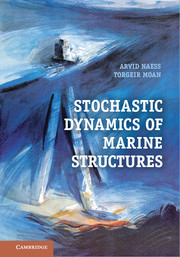Book contents
- Frontmatter
- Contents
- Preface
- 1 Preliminaries
- 2 Dynamics of Single-Degree-of-Freedom Linear Systems
- 3 Dynamics of Multi-Degree-of-Freedom Linear Systems
- 4 Finite Element Method
- 5 Stochastic Processes
- 6 Variance Spectrum
- 7 Environmental Loads
- 8 Random Environmental Processes
- 9 Response Spectrum
- 10 Response Statistics
- 11 Statistics for Nonlinear Problems
- 12 Short-Term and Long-Term Extremes
- 13 Dynamic Load Effects for Design Checks
- 14 Equations of Motion
- 15 Numerical Solution Techniques
- 16 Monte Carlo Methods and Extreme Value Estimation
- A Integrals
- B Poisson Process
- C Statistical Moments and Cumulants
- References
- Index
4 - Finite Element Method
Published online by Cambridge University Press: 05 February 2013
- Frontmatter
- Contents
- Preface
- 1 Preliminaries
- 2 Dynamics of Single-Degree-of-Freedom Linear Systems
- 3 Dynamics of Multi-Degree-of-Freedom Linear Systems
- 4 Finite Element Method
- 5 Stochastic Processes
- 6 Variance Spectrum
- 7 Environmental Loads
- 8 Random Environmental Processes
- 9 Response Spectrum
- 10 Response Statistics
- 11 Statistics for Nonlinear Problems
- 12 Short-Term and Long-Term Extremes
- 13 Dynamic Load Effects for Design Checks
- 14 Equations of Motion
- 15 Numerical Solution Techniques
- 16 Monte Carlo Methods and Extreme Value Estimation
- A Integrals
- B Poisson Process
- C Statistical Moments and Cumulants
- References
- Index
Summary
Introduction
The finite element method (FEM) is a numerical approach for solving partial differential equations in an approximate manner. It provides an efficient method for discretizing a structure in space and representing the dynamic variation of loads and response in time. In this context, the focus is on using the FEM to discretize the structure in space and then establish the equations of motion by consideration of dynamic equilibrium.
Structural analysis is generally based on three principles:
Equilibrium (local and global equilibrium in terms of stresses, stress resultants, and forces)
Kinematic compatibility (between strains and displacements)
Constitutive relationship (between stresses and strains/moments and curvatures)
In classical structural mechanics, these principles can be applied to establish exact relationships, e.g., between end forces (and moments) and the corresponding displacements of bars and beams. These relationships can be given in matrix form and used to discretize frames and trusses; they are commonly denoted the matrix method, see, e.g., Sack (1984); Felton and Nelson (1997); McGuire et al. (2000); Moan (2003). The finite element method can be used to establish such relationships by applying the principle of virtual work, minimum potential energy, or other variational principles. Both the matrix method and the FEM for bars and beams are briefly discussed. However, the FEM is more general and can be applied to analyze continuous plane stress, plate bending, shell, and solid three-dimensional structures.
Information
- Type
- Chapter
- Information
- Stochastic Dynamics of Marine Structures , pp. 98 - 141Publisher: Cambridge University PressPrint publication year: 2012
